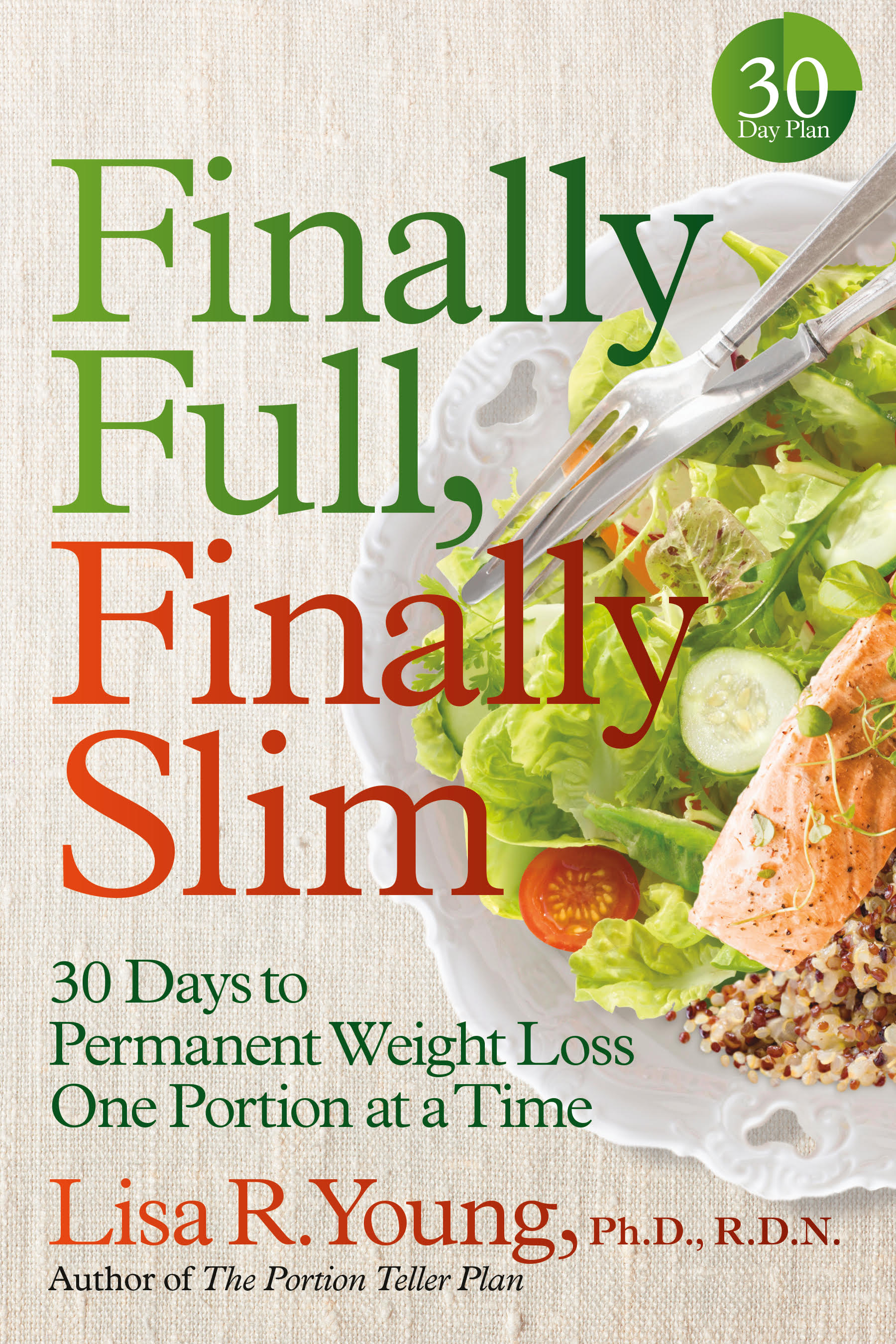Lisa R. Young, Phd, RD, is a nutritionist and NYU professor who has been spreading the portion control gospel for a long time. In her newest book, Finally Full, Finally Slim: 30 Days to Permanent Weight Loss One Portion at a Time, she explains exactly how eating the right portions is key to both weight loss and an overall healthy lifestyle. She also lays out a specific strategy for you to get smart about portions day to day. “I teach you how to enjoy food as nature intended—by consuming healthy portions of foods from all of the food groups,” she says. Here, she shares an excerpt from the book on how eating food—not nutrients—fits into that bigger picture.
Eat Food, Not Nutrients
If you live long enough, you’ll witness the seesaw mentality behind trending diets that focus on one nutrient, namely, fats, carbohydrates, or protein. Current diets have generally divided dieters into two camps. One advocates for a low-carb diet and the other for a low-fat regimen. People can and do lose weight on both of these types of diets. When Dr. Christopher Gardner and colleagues at Stanford University School of Medicine compared the weight loss of people on a low-carb diet with that of people on a low-fat diet in the Diet Intervention Examining the Factors Interacting with Treatment Success (DIETFITS) clinical trial, they discovered that one strategy does not necessarily work better than another for any given person. If you restrict carbs or fats, and eat fewer calories than you burn, you will lose weight.
RELATED: A Simple Guide to the 7 Most Popular Diets
The bigger, more relevant point is that the majority of people on super-restrictive diets eventually end up regaining their weight. They don’t stay on the diet, so it really doesn’t matter whether it produces weight loss. What matters is that it doesn’t work for them in the long term. In the Stanford University study, the X factor for long-term weight loss was not a single nutrient but the fact that dieters changed their relationship with food. Successful dieters—whether in the low-carb or low-fat camp—were more mindful when eating and ate more meals at home and with family. They changed their behavior and were more satisfied.
Calorie intake, overall food choices, the ability to keep the weight off, and lifestyle—not one nutrient—determine whether any food plan is good for weight loss. When we stop eating an entire food group, we compensate by eating more of something else, and that choice isn’t always as healthy as what we’re cutting out of our diet. Why not balance our intake of calories across fats, carbohydrates, and proteins by eating healthy food choices from each of the food groups in proper portions? We give ourselves the best chance at long-term weight loss and better health.
The fat-free nineties
The carb-heavy diets of the 1990s are proof in the pudding for how focusing on one nutrient can do more harm than good. The movement to reduce fat in the diet began in the late 1980s, when research linked saturated fats (found in red meat, butter, and full-fat cheese) with heart disease and all fats with weight gain. Many people did their best to limit fat intake, hoping to shed unwanted pounds and get healthy at the same time. So much so that they turned to anything fat-free—big white bagels (served dry, or with no butter) and fat-free muffins the size of bowling balls. In the nineties, even fat-free, sugar-rich treats such as licorice, jelly beans, and candy corn were free for the taking. It’s not logical to think that if you eat an entire bag of fat-free licorice you won’t gain weight, but I still run into many people who equate fat-free with weight loss.
Fat-free dieters made two big blunders. By shunning fat, dieters cut out healthy fats too, such as nuts, nut butters, olive oil, and avocados—all of which are good for you in moderation. Dieters also consumed excess sugar and calories by eating the fat-free cookies and other products that hit the market. (Fat-free processed foods tend to be high in sugar and calories and low in fiber and nutrients.) Instead of losing weight, Americans were putting it on. National dietary intake surveys found that we were eating excess calories—and many of them were coming from carbohydrates. We were inhaling carbs—and not the good ones either.
RELATED: Olive Oil vs. Coconut Oil: Which Is Healthier?
The pendulum swings
Fast-forward twenty-plus years, and fat is back. Research that condemned added sugar as bad for health, along with new evidence that showed the benefits of good fats, brought fat back and put carbs (especially sugars) on the list of foods to steer clear of. While the Atkins diet, around since the 1970s, has always shunned carbs, some trendy diets (including the keto diet) now focus on eating fats over carbs as a way to trim down. Yet fat has nearly twice as many calories as carbohydrates (9 versus 4 per gram). This puts us right back to where we were in the nineties, just in reverse. We’ve replaced carbs with fat. Either way, we are eating more calories than we need to and abandoning the health benefits of healthy carbs such as whole grains and starchy vegetables.
Have your cake and eat it too
It’s not always about what foods you cut out but what foods you add in. If you eat a handful of nuts with fresh fruit as a snack, there’s a good chance you’re not going to eat cookies. Fruit and a portion-friendly serving of nuts are all-around healthier choices (containing healthy fats and healthy carbs) for someone looking to lose weight. There are good carbs and good fats. But more is not better. You can’t eat as much as you want. Too much of one or the other leads to weight gain. Likewise, if carbs are bad, that alone doesn’t make fats good—and vice versa.
Fats are a good example when it comes to singling out nutrients for weight loss or health purposes. All fats have about the same number of calories and can equally contribute to weight gain when consumed in excess. One tablespoon of olive oil has about 120 calories and 1 tablespoon of butter just over 100 calories. “Healthy” fats do not have fewer calories than “unhealthy” fats, so swapping butter (nearly 70 percent saturated fat) for olive oil (about 13 percent saturated fat) is not going to make a difference on the scale. But from a health perspective, olive oil is far better than butter when part of a balanced diet. Olive oil is high in monounsaturated fatty acids (healthy fats). But consuming ½ cup of olive oil a day—or 8 tablespoons’ worth and 960 calories—is not going to make us healthier. It would just make us fatter. Always watch your portions, even with healthy foods.
RELATED: A Quick Primer on Healthy Portion Sizes
When you take something out of your diet, consider what you’re adding back in. Replacing saturated fat (one less-healthy nutrient) with refined carbohydrates (another unhealthy nutrient) doesn’t help our cause in the health department. When Harvard researchers compared the risk of heart disease in people with high intakes of healthy fats and whole grains with that in people who ate diets high in saturated fat and refined carbohydrates, they learned that people who ate healthy fats and whole grains had the lowest rates of coronary heart disease.
Bottom line: Focus on eating healthy food in thoughtful portions, not on a single nutrient. Follow the Plan and you can stop worrying about it.
Excerpted from Finally Full, Finally Slim: 30 Days to Permanent Weight Loss One Portion at a Time, by Lisa R. Young, PhD, RD.
(Featured Photo: Shutterstock)






























